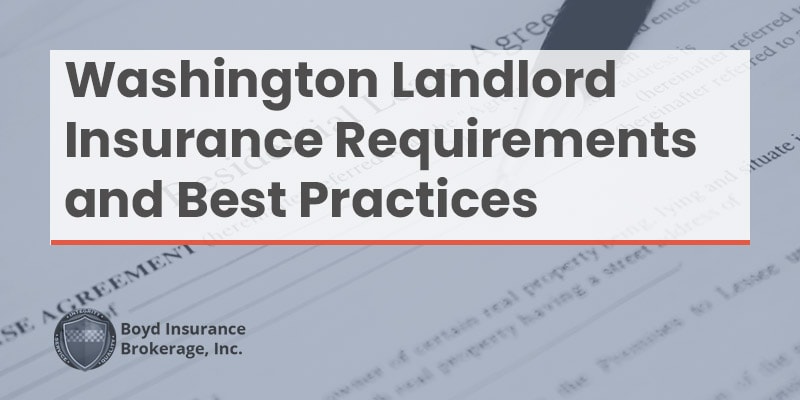Do you rent properties in Washington state? If you do, you should have a landlord insurance policy. Landlord policies, unlike homeowners’ policies, are designed to cover properties that are rented. While it’s not required by law, the Rental Housing Association of Washington (RHAWA) recommends that all landlords who rent properties get a landlord insurance policy. It’s important to note that if you own units with more than three units, you can get a commercial landlord insurance policy.
When Landlord Insurance Is Required
While there’s no legal requirement for landlord insurance, your lender will most likely require it. This means that if you’re still paying a mortgage or loan for your rental property, you’ll need to have landlord insurance in the amounts specified by your financial institution, and you’ll want to make sure that the policy is valid for the entirety of your loan.
The Kinds of Landlord Insurance Available
There are three types of landlord insurance available in Washington for landlords who rent properties with three or fewer units.
Dwelling Fire Form 1
Dwelling Fire Form 1 is often shortened to DP-1. It is a form of insurance that protects rentals. It’s important to note that this is a named perils policy, which means that if the peril isn’t named, it isn’t covered. Typically covered perils include fire and lightning damage, windstorms, hail, riots, smoke damage, damage from aircraft and vehicles. It’s important to note that vandalism and theft are not mentioned in this policy. It’s because they’re not covered. Additionally, this policy is usually paid out according to the current cash value of the property, not its replacement value. However, this policy is great for landlords who don’t have a lot of extra cash to spend on landlord insurance but still want some coverage.
Dwelling Fire Form 2
DP-2 coverage is more robust than a DP-1 policy. However, it’s still a named perils policy, meaning that if the peril isn’t listed, it isn’t covered. However, with this policy 18 types of damage are covered, and these include everything listed above plus falling objects, damage caused by someone breaking into the rental property, cracking and bulging, frozen pipes, electrical damage, glass breakage, and collapse. It also covered electrical damage, heavy snow, like if it were to damage your rental property’s roof and vandalism.
Dwelling Fire Form 3
DP-3 policies are the most robust and customizable. They’re also the most expensive type of landlord insurance you can buy. This policy is great if the landlord owns rental properties that contain older roofs. In most other policies, the roof isn’t covered if it’s more than 10 years old. They also typically have an open perils clause. This means that the damage is covered unless it’s expressly excluded.
Perils that are typically excluded in these policies include ordinance or law insurance. This coverage helps pay for any upgrades that are mandated by law after your building has been damaged by a covered event. For example, let’s say your building suffers electrical damage, and since the building was built or last upgraded, the electrical codes have changed. These changes result in higher costs. If you don’t have ordinance or law coverage, you’d have to pay for the electrical upgrades yourself.
Additional items that are usually excluded include exterior water damage, Earth movement, like Earthquakes or mudslides, power failures, lack of maintenance or neglect, nuclear hazards, war, actions by the government and mold damage.
Commercial Landlord Insurance
If you own properties with more than four units, you’ll most likely need a commercial landlord insurance policy. Commercial landlord policies typically include property insurance, general liability, equipment breakdown insurance, loss of income if you can’t rent your property due to damage, building ordinance insurance and documents insurance.
Landlord Insurance Best Practices in Washington
If you’re a landlord in Washington, you should seriously consider getting a landlord insurance policy. While it’s not required, it is a good idea if you want to financially protect yourself against covered perils for your rental properties. This is because your homeowners insurance policy does not cover damage in a house where the owner isn’t the primary occupant.
Determine the Types of Hazards You’re Most Likely to Encounter and What You’d Be Willing to Cover from Your Finances
To help ensure that you get the best policy for your needs, consider the most common types of perils you’d be likely to encounter. For most landlords, they would be vandalism or burglary while the unit was empty or between tenants. Your property may also be susceptible to wind damage and hail damage. If your property is in an area with a history of riots or illegal street takeovers, you may be worried about damage caused by those individuals. If these are the types of damage you’re primarily worried about, you might consider DP-1 if you can cover the costs of burglary and vandalism yourself, or you may want to consider a DP-2 policy that covers all of the hypothetical hazards. If the roof on your rental property is more than 10 years old or you want to customize your coverage, you should consider getting a DP-3 policy. If you own larger rental properties, you’ll want to explore commercial landlord insurance.
Getting Landlord Insurance with Boyd Insurance Brokerage Inc. in Spokane
If you’re not sure what type of landlord insurance policy you need and can afford, our insurance brokers at Boyd Insurance Brokerage Inc. can help you find the right policy. We can answer your questions about what each policy covers and explain the most common hazards that landlords face so that you can make an informed decision.
To get a quote for landlord insurance in Washington, give us a call at 509-340-2693.

